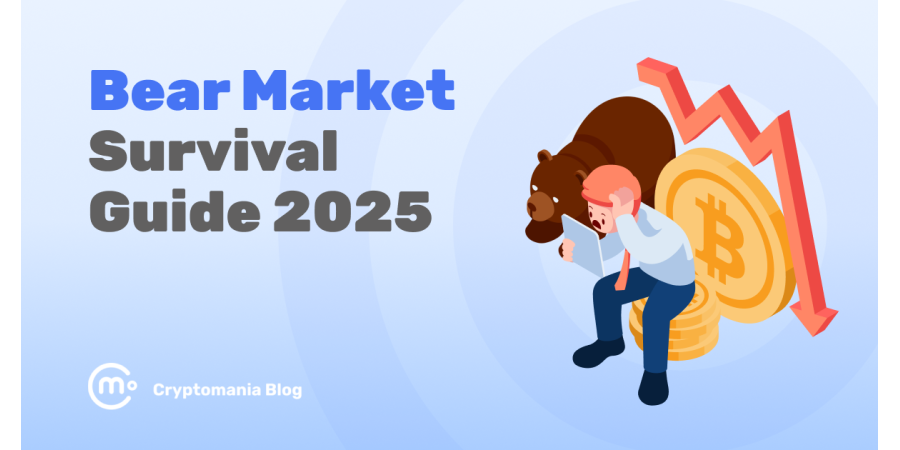

It’s all fun and games until it’s not for crypto.
In less than two months, the Fear & Greed Index slid from chest-thumping Greed straight into Extreme Fear. This is the lowest sentiment we’ve seen since the Terra-Luna meltdown that dragged the entire market underwater back in 2022.
So if you’re looking at your portfolio, wondering what exactly is happening, whether we’re in a bear market, and, most importantly, what you’re supposed to do now… you’ve come to the right place.
Let’s sort out what a bear market really is, what defines it, how long it usually lasts, and the smartest ways to survive it without panic-selling your sanity.
What is a bear market?
A bear market is the part of the cycle where prices fall, confidence evaporates, and crypto Twitter suddenly forgets every bullish narrative it screamed about last month.
In simple terms, a bear market is a prolonged period where assets drop 20% or more from their recent highs and keep drifting down instead of recovering.
In crypto, it hits harder because:
- Liquidity disappears fast
- Retail leaves even faster
- Narratives die overnight
- Volatility spikes on both sides (yes, even pumps look suspicious)
A bear market isn’t just “a dip.” It’s a shift in the entire mood of the market.
Funding turns negative, volumes shrink, and every minor bounce gets called a “bull trap.”
If it feels like the market is punishing optimism — that’s usually how you know you’re in one.
Are we in a bear market?
Short answer: The market is definitely acting like it wants to be one.
Just yesterday, on November 18th, Bitcoin flashed a signal everyone loves to panic about… the Death Cross.
Death Cross happens when the 50-day moving average crosses below the 200-day moving average.
:max_bytes(150000):strip_icc():format(webp)/dotdash_INV-Golden-Cross-vs.-Death-Cross-Whats-the-Difference-July-2021-01-a32d8a41a8d94860873836f077a21e39.jpg)
Some traders swear it means Bitcoin is heading straight back into a full-blown bear market. Others joke that it’s more like an exorcism ritual to chase away the demons dumping the market.
Historically, this setup is considered a bearish indicator.
And here’s the fun part:
Through the entire history of crypto, this is already the eleventh Death Cross.
Not all of them triggered catastrophic crashes… but most didn’t exactly signal a bull party either.
So, are we in a bull or bear market?
Definitely not in the bull one. We’re at least in a bearish phase: lower highs, weaker liquidity, fading narratives, and sentiment at its lowest since the 2022 Terra-Luna collapse.
Whether it becomes a full bear market depends on how the price reacts over the next weeks. But the market’s behavior right now is anything but bullish.
What defines a bear market?
A bear market isn’t just “prices went down.” If that were the rule, crypto would be in a bear market every other Tuesday.
A real bear market is a combination of factors. It forms when multiple signals line up at the same time.
Here’s what actually defines the bear market:
1. Consistent lower highs and lower lows
The charts stop recovering. Every bounce gets weaker. Every rally dies faster.
You don’t see “accumulation,” you see gravity in the action.
2. Liquidity dries up
When things get bearish, volume disappears.
Market makers pull back, order books thin out, and even decent news barely moves the price.
3. Sentiment turns negative (and stays there)
Fear dominates. It’s what we see today.
Social feeds flip from “next bull run soon” to “crypto is dead.”
Retail interest collapses, and Google searches go quiet.

4. Narratives stop working
Last month’s “revolutionary tech” suddenly becomes “another bag I shouldn’t have bought.”
Hype cycles stall. Projects stop delivering catalysts. Everything feels stuck.
5. Funding and open interest fall
Traders lose appetite for risk.
Leverage unwinds, funding turns negative, and even degens take a break.
6. Capital moves to safety
When stablecoin dominance rises and people start bragging about holding USDT like it’s a personality trait, it means you’re deep in bearish territory.
A combination of factors is what truly marks a bear market. It’s 3 distinctive shifts: sentiment shift, liquidity shift, and a trend shift. All happening at once.
And it’s telling you the market isn’t just “dipping.” It’s telling you the cycle has changed.
When was the last bear market?
The last real crypto bear market happened in 2022, and it wasn’t subtle. It started with inflation fears and a tired post-bull market, but the real crash came when the industry set itself on fire from the inside.
First, Terra-Luna collapsed, wiping out tens of billions and dragging the entire market straight into panic mode.
Then Celsius, Voyager, BlockFi, Three Arrows Capital, and a few other “too big to fail” players failed anyway.
And just when everyone thought the bleeding stopped, FTX blew up and took market confidence with it.
The numbers were brutal:
- Bitcoin fell from ~$69,000 to around $15,500
- Ethereum dropped from ~$4,800 to under $900
- Altcoins? Many lost 90%+ and never recovered
- NFT volumes evaporated almost overnight
Sentiment stayed at rock bottom for months, and liquidity dried up. Anyone who entered the market in 2021 suddenly discovered “long-term holding.”
This period, late 2021 to late 2022, is widely considered the most painful and dramatic crypto bear market to date. And judging by the current Fear & Greed Index, the market hasn’t felt this gloomy since that exact period.
So yes, we’ve seen worse. But the mood right now is kind of starting to rhyme with those days.
What to do in a bear market?
A bear market feels chaotic, but your approach shouldn’t be. When prices slide and narratives die, the smartest move is to stop reacting emotionally and switch into strategy mode.
Here’s what you should focus on:
1. Stop chasing hype
If a project wasn’t interesting when the market was green, it won’t magically become a gem now. Ignore panic pumps, influencer “secret picks,” and anything with a chart shaped like a cliff.
2. Cut emotional trading
Fear makes you sell bottoms. FOMO makes you buy tops.
A bear market punishes impulsive moves harder than anything else.
3. Avoid high leverage
You have to understand, you’re not proving anything by taking 25x shorts or trying to “catch the reversal.”
Bear markets love liquidating overconfident traders. Just stay on spot, reduce risk, and keep your account alive.
4. Keep dry powder
Holding a portion of stablecoins isn’t “giving up”, it’s positioning.
Bears create discounts. You want to have capital ready when they appear.
5. Focus on assets with real utility
Hype tokens dissolve in downturns. Quality projects with actual usage, revenue, or strong ecosystems tend to survive and recover.
6. Review your risk management
If the current drawdown scares you, your risk was too high. A bear market is the perfect time to rethink position sizing, diversify smarter, and build rules you can actually stick to.
7. Zoom out and stay rational
Bears end. They always do. Your job isn’t to time the exact bottom, it’s to avoid destroying your portfolio before the next cycle begins.
How to survive and benefit from a bear market
If you play it right, it’s the phase where most long-term gains are born.
Here’s how to stay alive and come out stronger.
1. Slow accumulation beats bottom-chasing
Trying to catch the exact bottom is how people end up with no position at all.
Instead, dollar-cost average into assets you actually believe in, like BTC, ETH, or top-tier alts with real usage. Small, steady buys outperform emotional lump sums 99% of the time.
2. Stick to spot, skip the leverage
A bear market rewards patience, not gambling.
Use spot positions. Avoid leveraged longs and shorts unless you enjoy donating to the exchanges. Staying solvent is the real alpha.
3. Let fundamentals guide you
When hype dies, fundamentals finally matter.
Pick projects with:
- strong development
- active ecosystems
- real revenue or clear utility
- long-term community support
Bears clean up the trash, but they also reveal what actually deserves to survive.
4. Hold stablecoins without shame
Not every dollar needs to be in the market.
Dry powder gives you flexibility, confidence, and the ability to buy when everyone else panics.
5. Educate instead of agonizing
A bear market is the best time to sharpen your skills.
Learn new strategies, backtest ideas, and use simulators instead of risking real cash. Future-you will thank you.
6. Manage your mindset
Bear markets trigger anxiety even in experienced traders. So, take breaks, unfollow doom-posters, and maybe reduce screen time.
Nothing gets fixed by staring at a red chart for eight hours straight.
7. Treat it like a long-term game
Cycles come and go, but most people fail because they panic-sell during fear and FOMO-buy during euphoria.
Surviving a bear market is simply resisting both.
Wrapping up: Bear markets feel brutal, but they’re also where real opportunities hide. You’ll benefit from the part of the cycle everyone else tries to avoid if you stay disciplined and cautious.





